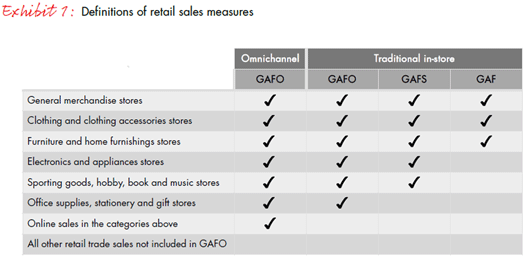Brief
Bain is forecasting omnichannel sales growth of 4% this holiday season, in line with last year. Our forecast encompasses both in-store and e-commerce sales for GAFO categories.1 We predict in-store GAFO sales growth of 2.5% to 3%, lower than last year’s 3% rate but in line with the 10-year average. We expect e-commerce sales to be a strong driver again, with growth of 15% to 17%. Continued improvement in financial markets, housing, and employment has increased consumer wealth and purchasing power, which bodes well for spending this holiday season. However, some watch-outs exist: Recent retail sales momentum, falling consumer confidence, and strong spending on durables could dampen GAFO sales in November and December.
Moderate growth across blurring channel boundaries
Bain expects omnichannel GAFO sales growth of 4% this holiday season (Figure 1). Our forecast includes both in-store and online GAFO sales because the two are increasingly difficult to separate. Omnichannel shopping is blurring boundaries, as customers move from personal computers to mobile devices to physical stores throughout the purchase process. For example, a customer may go to a store and see a product she wants, compare prices on her mobile phone, and later buy the product on her computer for pickup in another store. Alternatively, while she is commuting home from work, she may buy a product on her tablet that is shipped from a nearby store to reduce delivery times. These omnichannel shopping behaviors enrich customers’ experiences but make sales attribution by channel, and even by device, far more challenging. Any discussion of in-store GAFO sales alone does not tell the whole story. So this year, for the first time, we are forecasting overall GAFO sales growth, across all channels.
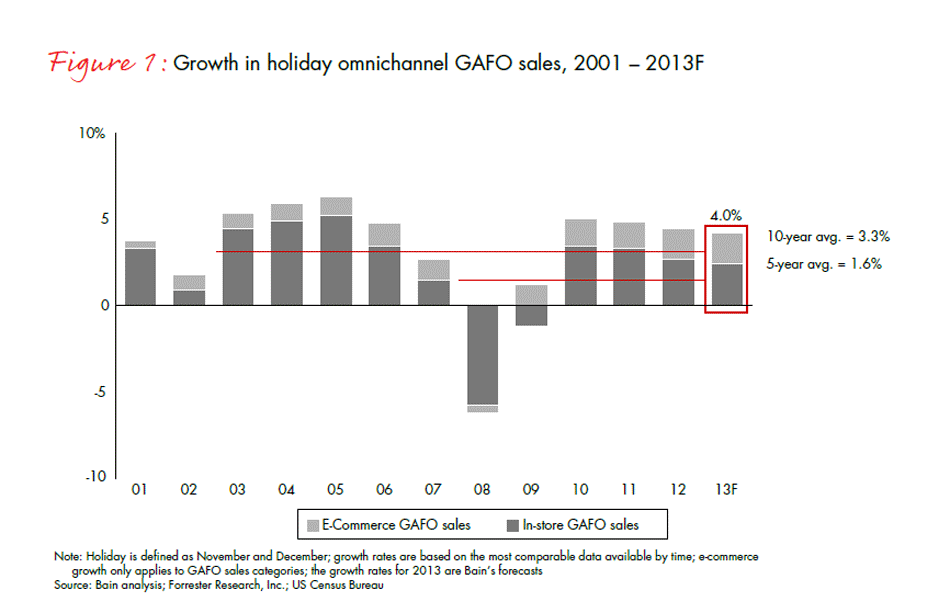
In-store GAFO sales are still critical to the holiday season, comprising roughly 90% of omnichannel GAFO sales. We forecast in-store GAFO sales growth of 2.5% to 3% in the 2013 holiday season, possibly below last year’s growth of 3% but above the 10-year average growth of 2.2% (Figure 2). E-commerce has continued to show strong momentum, with 18% growth in the second quarter and 16% estimated growth in the third quarter of 2013 (Figure 3). Increases in e-commerce sales are being driven by consumers’ growing adoption of tablets and other mobile devices, and by retailers’ investments in better mobile sites and applications. Bain believes that e-commerce will continue its strong momentum and grow 15% to 17% this year. As a point of comparison, analysts expect Amazon’s US sales to grow 24% during the last quarter of 2013.
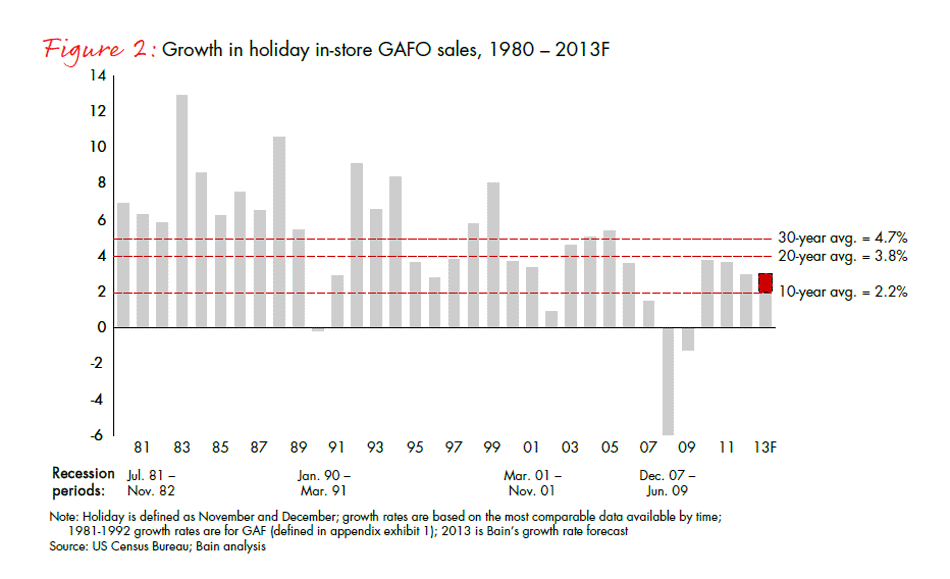
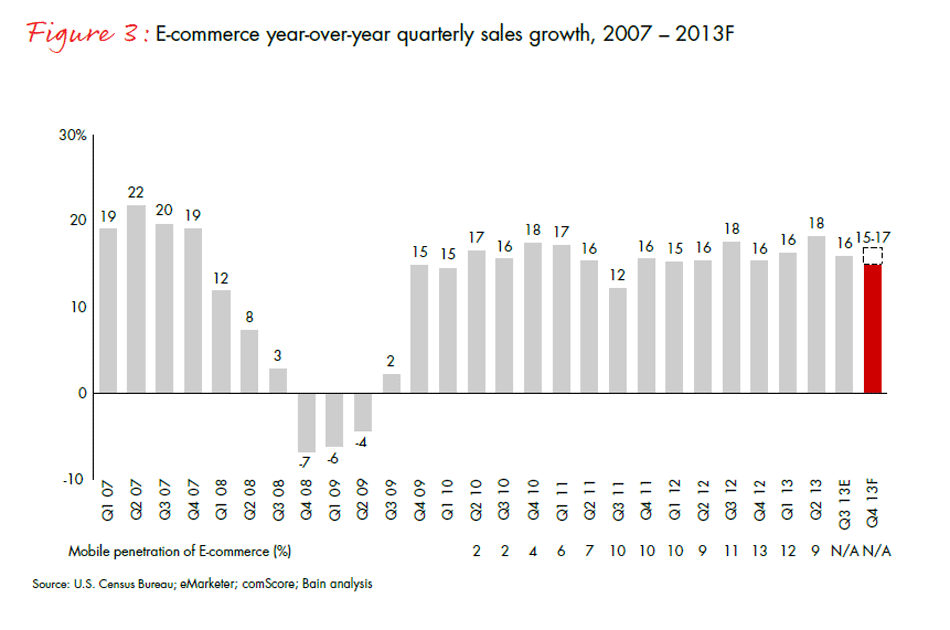
Macroeconomic foundations offer a mixed message
Macroeconomic foundations create a varied environment for this holiday season (Figure 4). Wealth metrics such as the S&P 500 Index, housing prices and unemployment numbers are most predictive of holiday sales, and this year they point to higher growth. At the same time, recent sales momentum, another predictor of holiday sales, has been sluggish; year-to-date GAFO sales have grown more slowly compared to both last year and the 10-year average. The contradiction between these indicators suggests that although consumers are on better financial footing, that may not translate directly into higher holiday sales growth. We discuss reasons for this later in the issue, including a shift in spending towards durables, and a recent downturn in consumer confidence.
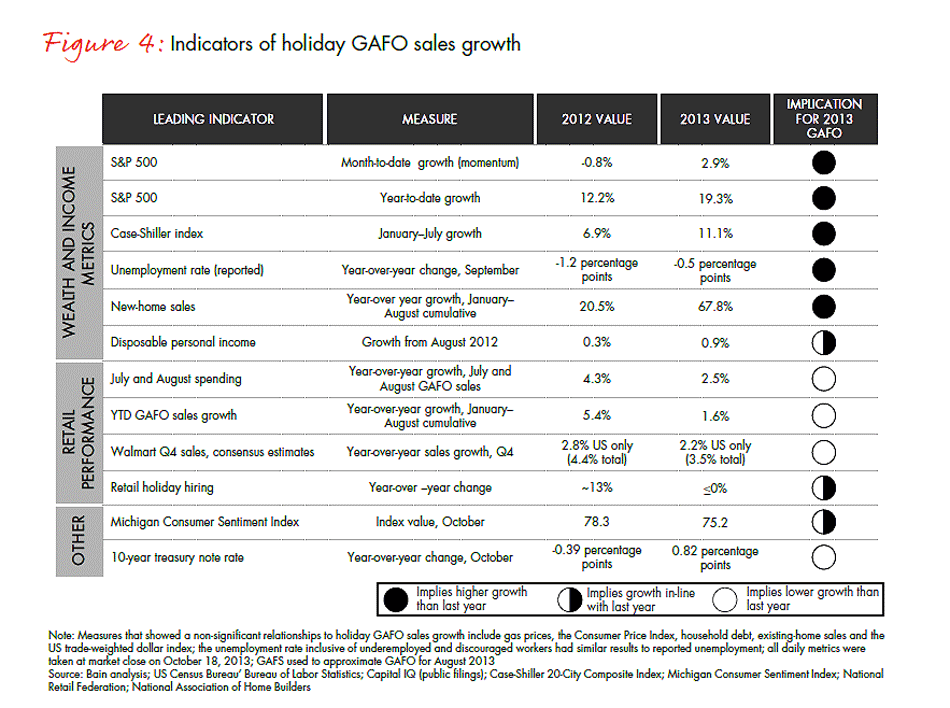
Consumers’ ability to spend is at its strongest level since the recession
This year, measures of consumer wealth and financial stability, including the S&P 500 Index, the housing market and employment data are up across the board. Consumers have more wealth and income to draw on this holiday season.
- Financial markets have had a blockbuster year, as demonstrated by the S&P 500 Index’s 19% year-to-date gain. The index is at historic highs, which is especially good news for more-affluent consumers, who have two-thirds of their wealth in financial assets. Since October 1, the S&P 500 has climbed 3%, evidence of strong momentum heading into the holiday season, especially compared to last year, when growth was flat over the same period.
- The housing market has improved this year, which, combined with low interest rates, will renew homeowners’ access to home equity lines of credit for holiday spending. The 20-city Case-Shiller home-pricing index is up 11% since January, versus 7% over the same period last year (Figure 5). The index is still well below its 2006 levels, meaning some owners are still underwater. That said, continued upward momentum in home prices is clearly a positive trend for consumers’ wallets and psyches. Similarly, new-home sales are up an impressive 70% this year versus an increase of just 21% during this period last year (Figure 6).
- Reported unemployment is down again this year, 0.5 percentage point since this time in 2012 and 2.5 percentage points over the past four years (Figure 7). The sum of unemployment, underemployment, and discouraged workers was also down, by 1.1% over the past year, more than the 0.5 percentage point decrease in unemployment alone. More jobs bode well for consumers’ confidence and their ability to spend this holiday season.


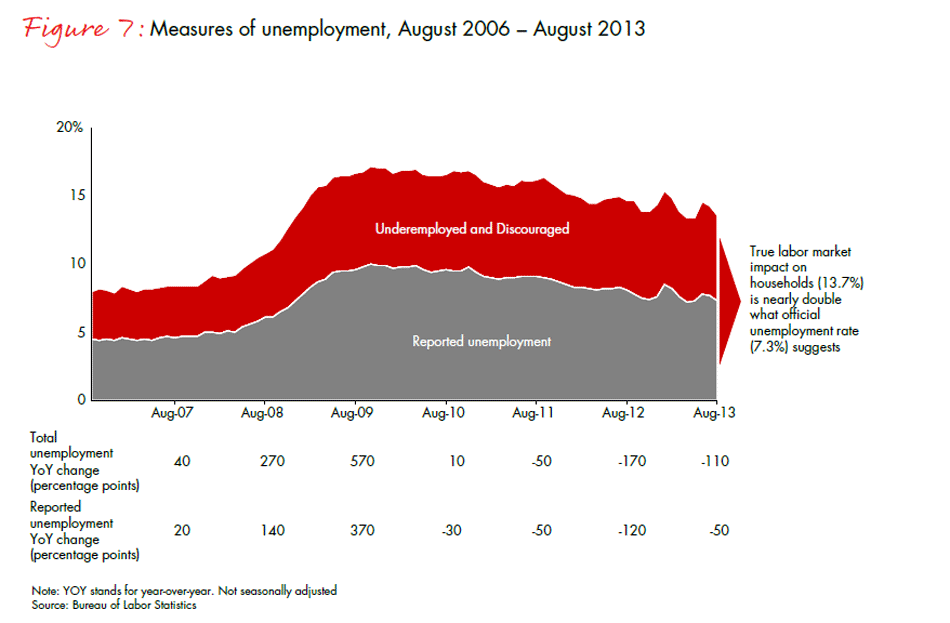
Where has all the spending gone?
In-store GAFO sales growth has slowed this year, increasing just 1.6% year-over-year during January through August 2013 versus 5.4% for the same period last year (Figure 8). Some of this slowdown is due to cannibalization from online sales, but other factors are also at work:
- GAFO sales in the first half of this year grew on top of a very strong 2012. This challenged the 2013 measures, as they had to grow off of a larger sales number. However, last year’s holiday growth was at slower pace, which means that this year’s holiday growth rates do not face as high hurdles as earlier in the year.
- This year, consumers have been spending more on durable goods (Figure 9). Consumer spending on motor vehicles and building materials between January and August increased by 10.1% and 6.5% respectively in 2013, much higher than their 10-year average increase over the same period (1.1% and 1.9% respectively). Because spending in these two durables categories is roughly as large as GAFO spend, GAFO growth has likely been impacted. The increase in durables spending probably is due to a combination of pent-up demand from the recession, anticipation of higher interest rates and aggressive marketing—trends that are likely to continue throughout the holiday season.
- Consumer confidence fell quickly over the past few months, from a high of 85 in July to 75 in October. Some of this drop was due to the government shutdown and the debt crisis. In last week’s deal, Congress reopened the government through January 15 and raised the debt ceiling until February 7, which should calm the financial markets and consumers through the holiday season. However, uncertainty about long-term solutions could continue to affect consumer confidence and spend.
- Although unemployment has dropped, even those fortunate enough to be employed see many of their neighbors out of work or underemployed. This creates a psychological headwind to discretionary spending, even among consumers who have recently acquired new wealth or income. Walmart has stated that its customers are feeling on shaky ground this year. In response, the retailer is planning to cut costs and offer “basic products” at lower prices.
- Most market analysts are predicting a slower holiday season this year. Fourth-quarter consensus estimates across the top 30 retailers suggest just 1% weighted average growth, and several research firms have predicted flat to falling hiring.

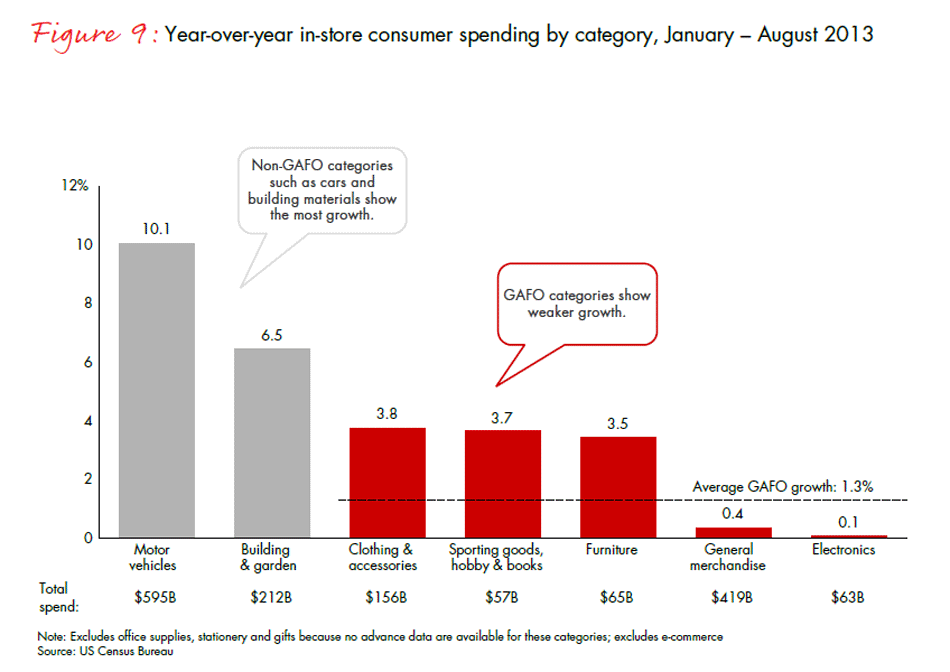
Retailers are sending mixed signals this holiday season
No one has greater insight into holiday sales than retailers themselves, which will drive sales based on their inventory, pricing, promotion, marketing, online, and store service strategies. Retailer-specific strategy and execution are leading to mixed outlooks:
- This year, Walmart is hiring 55,000 seasonal workers compared to 50,000 in 2012. But the company recently lowered its global fiscal year 2014 sales growth estimate from 5% to 6%, to 2% to 3%.
- Informed by data analysis of shopping patterns, Target has significantly decreased its seasonal hiring, from 88,000 in 2012 to 70,000 this year.
- Toys “R” Us and Kohl’s will maintain holiday hiring at 2012 levels, adding 45,000 and 50,000 seasonal workers respectively.
- Amazon.com expects to increase its seasonal positions this year from 50,000 to 70,000 in response to increased customer demand.
Successful retailers are innovating to deliver a superior omnichannel experience for their customers
This season more retailers will deliver seamless omnichannel experiences and roll-out innovations in fulfillment, marketing, pricing and information technology. Target plans to have its “Buy Online, Pick Up in Store” service operating at all 1,800 of its US stores by Black Friday. Macy’s will be using at least 500 of its 800 stores as online fulfillment centers by the end of the year. Walmart has launched an improved mobile app that “scans as you shop,” expediting access to product reviews and checkout. EBay is investing heavily in new mobile-payment technologies. Staples, Target, Toys “R” Us and Best Buy are all promising to match Amazon.com’s pricing. Other retailers are using technology to empower store associates to make real-time pricing decisions.
For a list of selected references, please view the full article
Appendix
